| So we came to Colonial Williamsburg which is a
theme park of the Revolutionary War period in US history. The Americans are
very good at this sort of thing and strive for accuracy with plenty of
people on hand to provide the living history. It is expensive to go in and
we got a two day ticket which we felt was good value. Here they are
building a log barn with traditional tools and methods which will ultimately be used to store the
corn they are growing in the adjacent field. They were proud to point out
that the top is within an inch of being level for the roof. The gaps will
ultimately be filled with clay and straw. The work will take a long time because they spend so much
time talking to the visitors! | 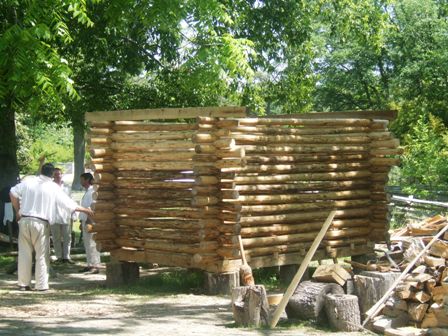 |
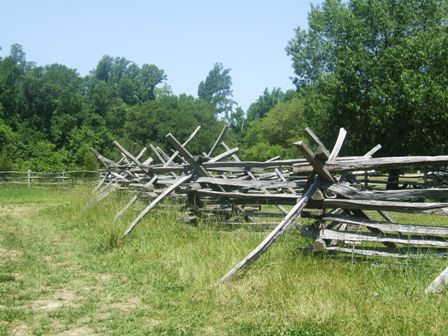 |
We had seen this style of fencing (known as Virginian split rail) at
Gettysburg and Antietam and we thought it was a military design. Not so. Apparently it
was used by the early settlers to keep animals OUT of the crops. We have
tried to establish where it came from before then but without success. Many
of the settlers in this area came from Lincolnshire but it isn't a style
from there. |
| This is one of the most imposing buildings on the
site which has a total of 88 original or replica buildings. It is a substantial brick
built mansion with much decoration as befits the Governor's residence. It was
built between 1706 and 1722 when Williamsburg was the capital of the colony
of Virginia (1699-1780). The building is a replica, the original having
burned down in 1781. It was reconstructed from drawings found on copper
plates in the Bodleian library in Oxford. | 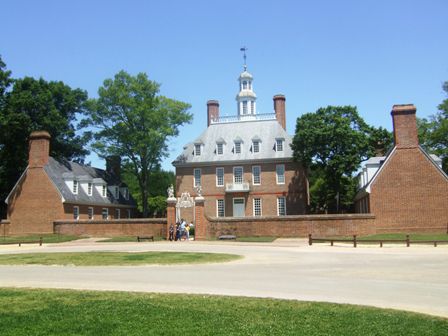 |
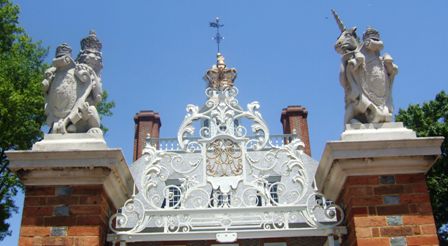 |
The gateway is surmounted by the lion and the unicorn and coats of arms for
King George since this was still an English colony at the time(1770). |
| We had a guided tour of the inside. There are several
imposing beds in the bedrooms. It is interesting to note that beds were
usually shorter and narrower
than they would be today although it should be remembered that wealthy
people mostly
slept alone. | 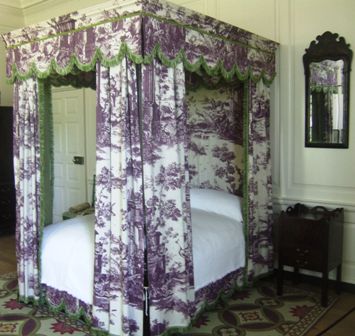 |
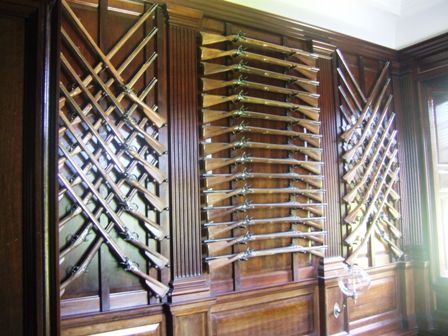 |
The walls in the entrance hall are amazing, being absolutely covered in
muskets and swords and rapiers, true to contemporary descriptions. This could have
been (and probably was) the arms repository for the county militia. In 1775
the inventory stated there were 230 muskets, 292 swords and 18 incomplete
pistols (without locks). So they stored them on the walls, both as a
decoration and as a visible deterrent. Williamsburg
probably has the largest number of Brown Bess muskets in the world collected
in the 1940-50s when nobody else wanted them. |
| An elegant ballroom had been added on with lofty ceilings,
chandeliers and paintings of King George and his wife on the walls. It is
interesting to note that the ballroom was originally carpeted and the walls were
papered with quarto sized sheets of paper. Wallpaper was very fashionable
but not yet available in rolls. The colours are also true to the period. | 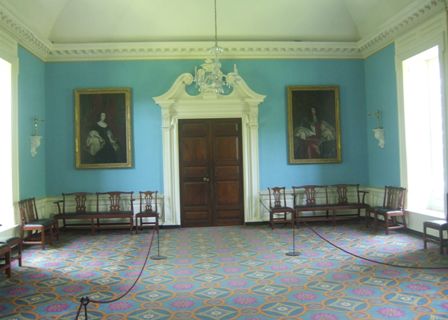 |
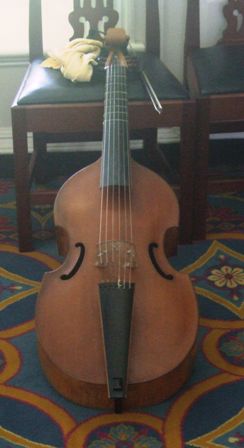 |
Music was very important in the higher levels of society and many of the
women particularly were accomplished musicians. Of particular pride is this
six stringed bass viol de Gamba. These instruments date from the 1400s and
were tuned in fourths (D-G-C-E-A-D) rather than the modern violins
which are in fifths. The outward facing C shapes suggest this is a 17th century
instrument. There are also several harpsichords on show. They even let one
young girl play one (she had some skills). |
| As there was no photography high society had their
portraits painted. I'm not sure they always got the proportions right. I'm
sure her head would have been relatively larger. This painting in the
ballroom was by Allan
Ramsey and is of Queen Charlotte (née Duchess Sophia Charlotte of
Mecklenburg-Strelitz; 1744 – 1818). She was the
queen consort of George III, the grandmother of Queen Victoria and the great-great-great grandmother of Queen Elizabeth II. | 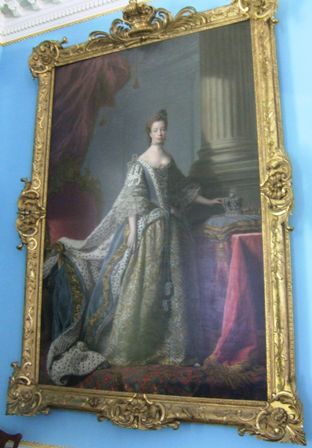 |
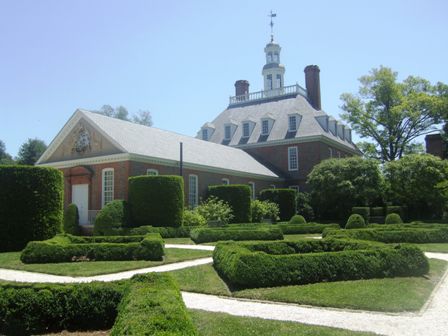 |
This shows the rear of the mansion with the ballroom surrounded by formal gardens
with boxwood hedges. There is a maze at the bottom of the garden. |
| Underneath are several cellars for storing beers,
wines, and food of all sorts. The kitchens were in a separate building to
avoid the danger of fire. | 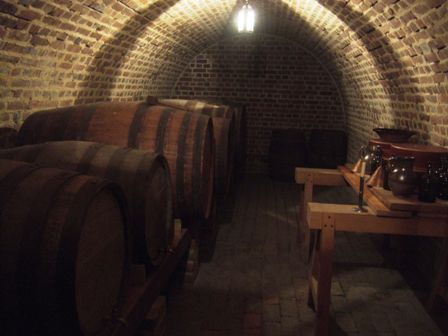 |
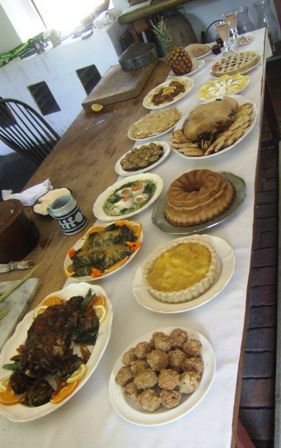 |
Besides growing many of their own vegetables using varieties and methods of
the time, the modern day kitchen staff also prepare meals of the time. This
would have been a typical family dinner. They make these just for display
and can keep them for up to four days before having to start over again.
Most of the time is spent keeping small fingers out! No wonder the higher
echelons were stout! |
| Behind the kitchen is the kitchen garden. Many more
herbs were grown and used than is common in most gardens today. | 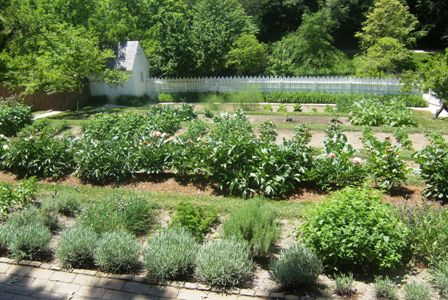 |
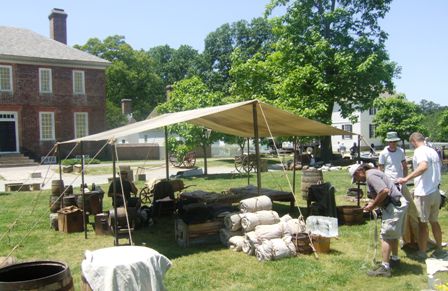 |
Out on the green was a cordoned off area in use by the props department of a
period film being shot in the complex. This is quite a common occurrence.
However we didn't see anybody famous and we don't even know which film it
was going to be. |
| Many buildings are open to the fee paying public.
Most are rather less grand than the governor's palace but show more of the wood
and metal utensils in everyday use. | 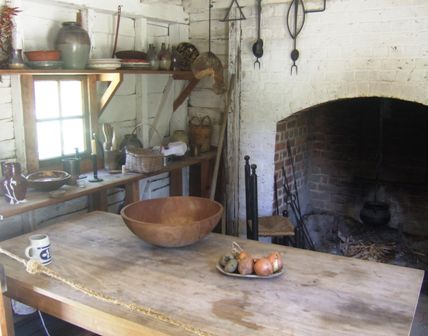 |
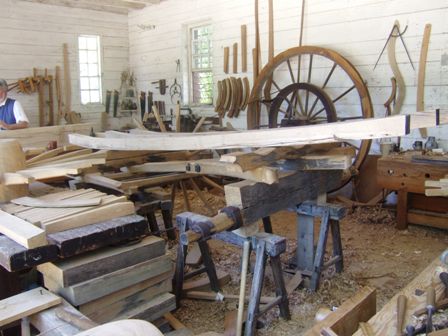 |
We found the workshops particularly interesting and most have docents on hand to
demonstrate the various skills. It is interesting that they still take on
apprentices and teach them the old skills. This is a wheelwright's shop. A
wheelwright was a very skilled man having mastered a great number of tasks
covering both wood and metalworking as well as considerable engineering
design. |
| I think this is the boot and shoemaker's shop. They
still make the shoes for the docents in the styles of the time. In the 1770s
they were just beginning to make right and left-handed shoes - before, each
shoe was the same and assumed right or left footed characteristics with
wear. | 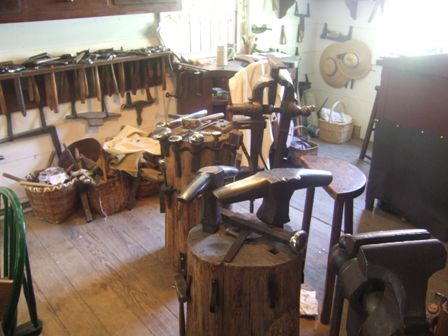 |
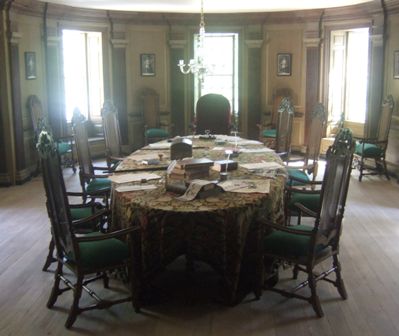 |
The other major building is the Capitol. This is the third building
constructed on this
site. The first was built in 1700-1705 and burned down in 1745. The second
was built in 1753, the west wing was demolished in 1793 and the east wing
burned in 1832. The modern replica was built in 1934. This was the seat of
the colony's government. |
| Virginia was originally a huge colony covering most of present
day Virginia, West Virginia, Kentucky, Ohio, Indiana and Michigan. A colony
in those days occupied the area between 2 latitudes and extended from the coast to the Ohio river.
The west was still owned by the French. | 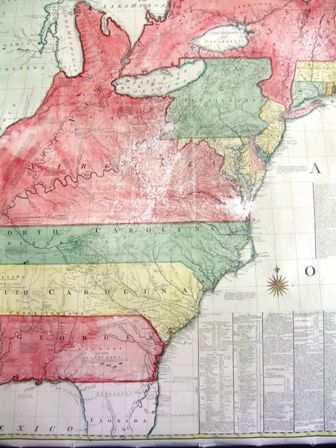 |
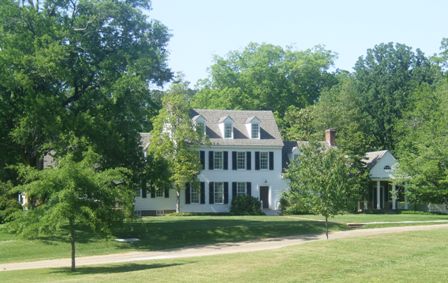 |
Modern Colonial Williamsburg came into being when Rev W A R Goodwin
persuaded John D Rockefeller to become interested in restoring the
historical area. His philanthropy eventually funded most of the early
purchase and recreation of the 313 acres it now covers. Rockefeller and his
wife fell in love with this house, Bassett Hall, and bought it as a Spring
time home. It was
one of their favourite homes and they furnished it with lots of art, hers art deco
and modern folk pieces and his more traditional (though I wouldn't give house room to
any of them). We did tour the house but
decided not to visit the gallery with more of her collections. |
| Williamsburg has daily re-enactments of the start of
the revolutionary process with speeches by actors representing people such
as Thomas Jefferson and Patrick Henry (both of whom later became governors).
This usually culminates in the firing of muskets and guns with a great deal
of noise to excite the kids. | 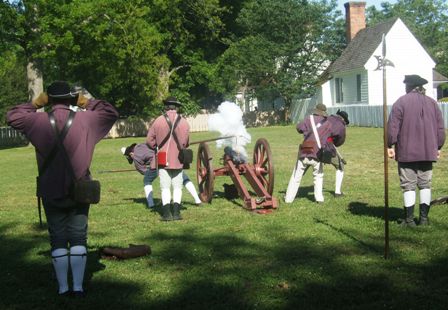 |
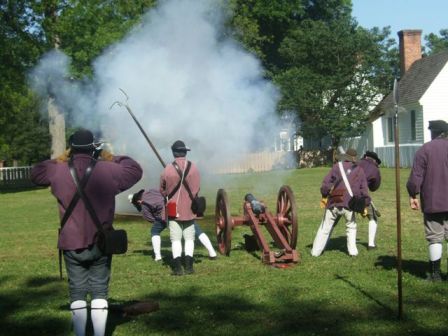 |
I tried very hard to capture the exact moment but the delay on digital
cameras makes this a very difficult art.. |
|